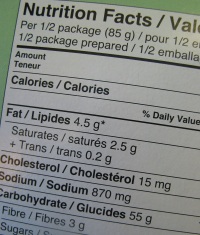Taste Success with QR Codes in Food and Wine Labels
 Food labeling is continually under pressure from government regulations and consumer demands for comprehensive information about the product: nutritional and ingredient information, “sell-by” dates, allergy implications, package recycling and more. This is a lot of information to include on a regular package label or traditional barcode. A well-designed QR (Quick Response) code on the label can expand the “real estate” necessary to provide consumers with product information, via their smart phones.
Food labeling is continually under pressure from government regulations and consumer demands for comprehensive information about the product: nutritional and ingredient information, “sell-by” dates, allergy implications, package recycling and more. This is a lot of information to include on a regular package label or traditional barcode. A well-designed QR (Quick Response) code on the label can expand the “real estate” necessary to provide consumers with product information, via their smart phones.
IMI Global and Heinen’s Fine Foods have launched an initiative that incorporates QR codes on the company’s beef and pork packaging.
The labeling program is aptly tagged, “Where Food Comes From®”, and is, according to company president Tom Heinen, a way to help customers learn more about the source of the beef and pork products they market, including where, how and by whom the food was raised. “The explosive popularity of smart phones is an indication to us that consumers are being more proactive in researching their purchases, and having access to information at point of sale is a major marketing advantage.”
The QR codes for the Heinen’s initiative are generated using tools from Google's open-source Zxing project (pronounced Zebra Crossing). Labels are then printed in Heinen's distribution centers, with approval from the USDA.
“We’ve been offering verification services to farmers and ranchers for 15 years, and Where Food Comes From® is our effort to connect that program with the consumers who are looking for information about the food they buy,” said Leann Saunders, president of IMI Global in a recent press release.
Eric Anderson, QuickLabel Upper Midwest District Manager, offered some ideas about using QR codes in food and wine labeling in a recent QuickLabel blog. “I like to call labels with QR codes ‘perpetual interactive marketing billboards’ that can be applied to most any product,” he posted, and offered a few examples.
-
Food companies could print a label with a QR Code that can be scanned for a “Recipe of the Month” by customers, with the QR code pointing to a web page that’s updated with new recipes. The container becomes a perpetual marketing tool.
-
Kellogg recently initiated an “It’s Morning Somewhere” campaign using QR codes on its Crunch Nut cereal. While consumers are eating breakfast, they can scan the code and be ported to a mobile site that features 13 promotional videos programmed for the time of day.
-
Private wine bottle labels could include a QR code that launches a YouTube video of different aspects of the couple’s wedding – a memento and conversation piece at the same time, and an added benefit for wine bottlers.
Farmers and food suppliers must verify the source of their products through the USDA. They can then add the QR code to their products to ensure more transparency in explaining to consumers about how the food was raised and processed. The additional promotional opportunities provided by QR package labeling offer a bonus level of credibility and ROI for the manufacturer and distributor, and a comfort level – even entertainment – for the consumer.
About IMI Global
IMI Global, Inc. is a U.S. Department of Agriculture (USDA) Process Verified company and is a leading provider of verification and Internet solutions for the agriculture industry. For more information, visit http://www.imiglobal.com//.
About QuickLabel Systems
QuickLabel Systems is a leading manufacturer of production-capacity, full-color digital label printers, barcode printers, and labeling software that allow businesses to “print your own labels” on-demand, just in time. See http://www.quicklabel.com/index.html for more information.
Related articles:
Grocery Applications for GS1 Databar: Managing Fresh Food More Effectively
Ready, Aim, Shop: QR Barcode Scanner Apps for Smartphones
{jcomments on}
